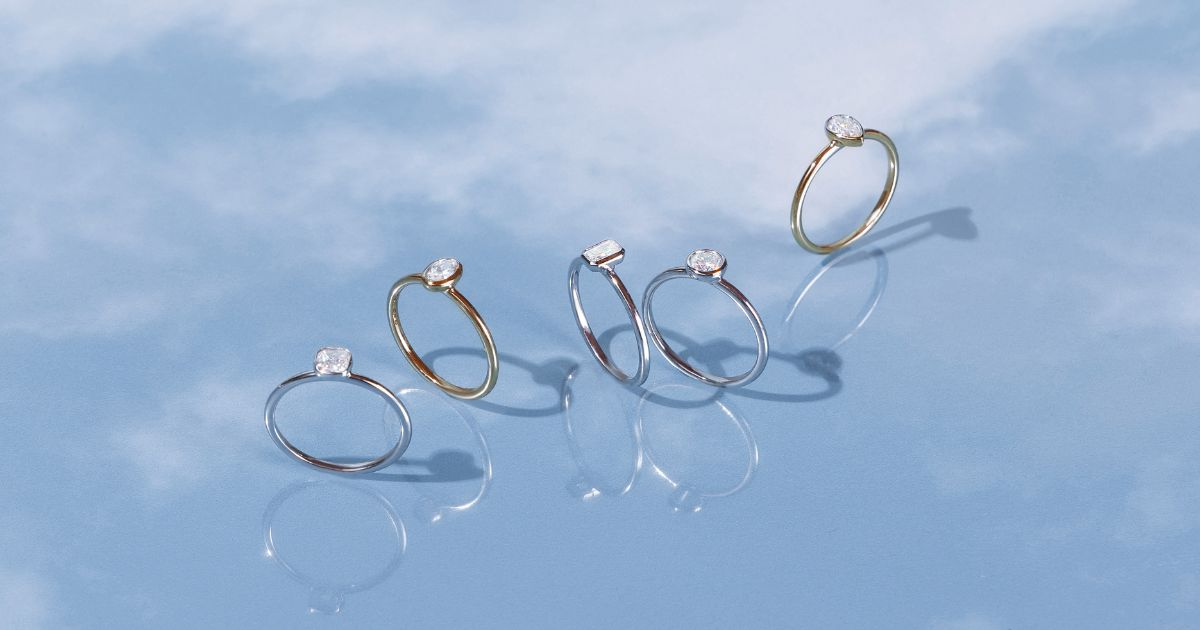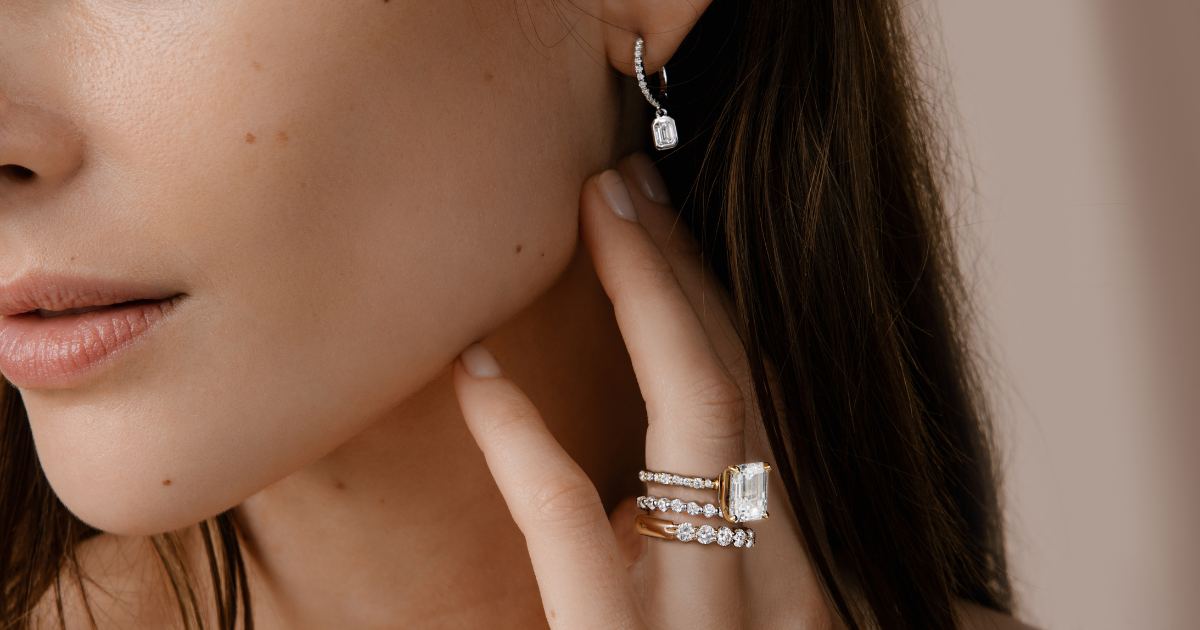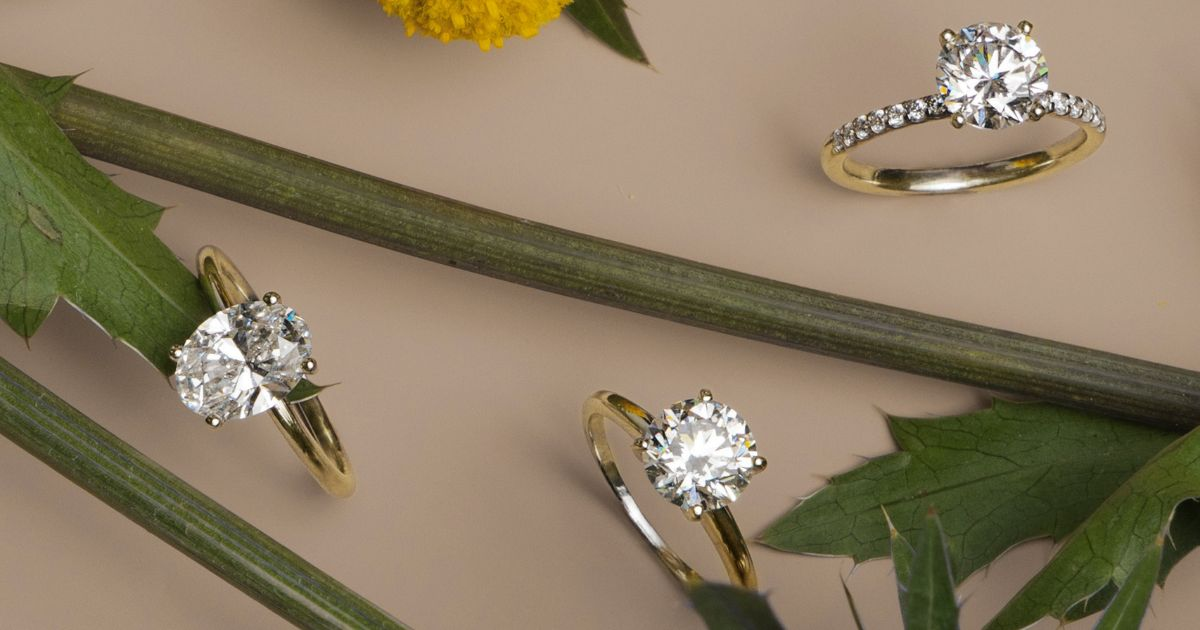Choosing the cut of your diamond engagement ring is one of the most exciting decisions you can make when considering your engagement ring. But for how much fun it can be, sifting through the many diamond ring cuts can also be stressful.
There are countless diamond shapes to choose from and understanding what exactly each shape is and means can be a lot for anyone! Not to worry though, as we’ve compiled a list of the different shapes of the diamond so you can find your perfect engagement ring. Keep reading to find out!
Diamond Shape vs. Diamond Cut

When discussing different diamond ring cuts it is first important to distinguish between the cut and shape of a diamond. While the terms can be (and are often) used interchangeably, there are some key differences.
What is a Diamond’s Cut?

When referring to a diamond cut, people often speak of the 4C category, cut. This is a measurement of how successfully a diamond has been cut to reflect the fire, scintillation, and brightness of the diamond.
Consider the analogy of a coloring book, while the shape of a diamond may be the physical shape and outline of the diamond or the picture a child is coloring, the diamond cut is the fine lines and colors the child chooses to add in.
Round brilliant cut diamonds are graded on a scale of Excellent to Poor according to the Gemological Institute of America. Only the round brilliant diamond is awarded a cut score. This is because the fancy-shaped diamonds are both too numerous and ever-changing to maintain a grading rubric that can faithfully represent every shape.
Despite this, Clean Origin has developed a scoring system to ensure accurate grading and will not offer any diamonds that are given a Fair grade or below.
What is Diamond Shape?

As mentioned above, if a diamond’s cut is the color and fine lines of a picture in a coloring book, the diamond shape is the general outline that makes up the picture. The body of a diamond can be known to bring out certain aspects of fire, brilliance, and scintillation, but the shape of a diamond will never be graded like a diamond cut.
What Are the Different Diamond Shapes of Engagement Rings?
There are a ton of different diamond shapes available and it can be difficult to know which shape may be right for you. Fortunately, we’ve broken down the key characteristics of each shape so you can better determine your ideal diamond. Let’s begin with two of the most popular diamond shapes: round diamonds and princess diamonds.
Round Brilliant Cut Diamond

Not to be missed, the round diamond is the most popular diamond shape…and for good reason! Beloved for its symmetry, a round-cut diamond contains 58 facets and a length-width ratio of 1 to 1.01 which results in a beautiful and classic look.
Wondering why round-cut diamonds are so popular? In part, it is thanks to the fact that they offer the most sparkle and brilliance of any diamond shape. The shape of a diamond is the most important factor in determining its brilliance and fire. Round-cut diamonds are considered the most brilliant because they allow light to enter from all angles, which results in maximum sparkle.
Princess-Cut Diamond

The Princess-cut is another immensely popular diamond, and it’s behind only the round diamond in terms of popularity.
The princess cut is a square-shaped diamond that is often admired for its unique square shape and pointed edges. The princess cut’s brilliance can really shine through when it comes to sparkle. In fact, it’s become one of the most popular diamond cuts because of its ability to create maximum fire and shine.
Cushion-Cut Diamond

Much like the princess-cut diamonds, a cushion-cut diamond has a square shape and are brilliantly cut. The difference lies in the corners- where the princess-cut diamond has sharp pointed ends, the edges of the cushion cut are rounded like a…well, cushion.
The rounded corners result in an appearance that is both timeless and modern. The cushion cut of the diamond also improves the durability of the diamond as the rounded edges decrease the likelihood of breaking or chipping over time. All in all, the cushion cut is a stunning diamond with its distinct corners and regal shape and deserves a spot on every person’s dream ring wish list.
Emerald-Cut Diamond

Timelessly glamorous, an emerald-cut engagement ring hearkens to the art-deco period and is perfect for the person looking for a unique ring style and square or rectangular shape to show their love.
Emerald-cut diamonds employ a step-cut faceting technique where a series of vertical planes are cut into the diamond, producing a shape with many flat surfaces and a step-like appearance.
As a result of this type of faceting, emerald-cut diamonds display a dazzling hall-of-mirrors-like effect that highlights the emerald-cut diamond’s clarity (and if you’d like to learn more about clarity, review our diamond clarity chart) and color grade.
Radiant-Cut Diamond

A radiant cut has a rare and distinctive look that can only be found in diamonds with a certain shape.
Radiant cuts have a prominent crown and pavilion, which makes them stand out as unique and eye-catching. They also have 56 facets (the same number as round diamonds), which makes them sparkle brightly when they catch the light.
The shape of this type of diamond is quite unusual—it’s somewhere between oval and rectangular in shape, with its corners rounded off slightly so that it looks round from any angle when viewed from the top down.
Pear Shape Diamond

Pear-shaped diamonds include the lower half being longer than the upper half resulting in an oblong shape. The shape entails a pointed tip at the bottom and flattened sides. This offers a wider appearance at one end than the other.
The shape of a pear-shaped diamond is comparable to that of an actual pear. This shape lends itself well to modern settings, such as solitaire or three-stone rings, because it creates more room for additional diamonds on either side of it to enhance its sparkle and beauty for a diamond engagement ring that is both stunning and breathtaking.
Oval Shaped Diamond

An oval-cut diamond is universally beloved for its ability to lengthen and slim the look of fingers because of its elongated shape and dramatic curved sides.
Oval engagement rings also more likely to appear larger than its actual carat weight. This is because oval diamonds are not as deep as round diamonds, so they seem to have more surface area that’s visible to the naked eye.
You can also use this same principle to your advantage when shopping for a ring that is not an oval-cut diamond engagement ring. If you’re looking at a diamond with a higher carat weight, but don’t want the ring to be too bulky or heavy, consider opting for an oval-shaped diamond instead.
Marquise Diamond

A marquise diamond is a historic shape. It originated in the 18th century when King Louis XVI requested a diamond cut matching the lips of his mistress, the Marquise de Pompadour. Thus, became the marquise shape. Its classic round and full center narrow into pointed tips on either end.
Like other engagement rings that utilize elongated shapes, a marquise-cut diamond engagement ring can appear larger than its established carat weight and is perfect for those looking for maximum size on a minimalist budget.
Asscher-Cut Diamond

The Asscher cut diamond is a classic in the world of diamonds. Developed by Joseph Asscher, he worked for the jewelry company “De Beers” in the late 19th century.
A distinctive and valuable shape, the Asscher cut features the same step-cut pattern as the emerald-shaped diamond. Asscher cuts are also unique thanks to their octagonal shape and four cropped corners. The resulting shape appears as a unique cross between the emerald, cushion, and princess cuts. Its beauty has become quite popular in recent years.
Heart-Shaped Diamond

Sure, you’ve heard of wearing your heart on your sleeve but how about on your finger? Heart-shaped diamond engagement rings promise to do just that with their one-of-a-kind heart shape and trendy style.
Heart-shaped diamonds also have a special meaning that reflects love, commitment, and trustworthiness as well as joy and happiness in marriage. This makes them ideal for couples who want a ring that represents everything they want from their relationship together. Want to make your heart-shaped diamond stand out? Consider solitaire engagement rings so it’s the star of the show.
How Do I Know What Diamond Engagement Ring is Right For Me?

The most important thing to consider when choosing a diamond engagement ring is whether or not it complements your personality. If you love being outdoors and are always doing something active, then Princess cut engagement rings might be right for you. It’s small and easy to wear on your finger without getting in the way. More of an introvert who prefers to stay home with a good book? Maybe a Round diamond would look better on your finger.
Sounds like too much work? If all this talk about personality is making your head spin, there’s another thing to think about. How often will you wear it? If you’ll only wear it occasionally—say, once per year on your anniversary date—then any shape should be fine. However, if intended for everyday wear, it’s worth investing in something special.
Clean Origin’s Selection of Premium Lab Created Diamonds

At Clean Origin, we believe that the most important thing about an engagement ring is how it makes you feel. That’s why our rings are created with lab-grown diamonds. You can rest assured that your ring is special—and not just because of its sparkle.
When you buy from us, you’re getting beautiful jewelry that’s ethically sourced. Our jewelry is made without any of the harmful effects of mining. This means no deforestation or pollution. So, you can feel confident that your engagement ring is as beautiful as it is ethical.



